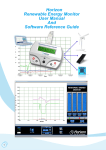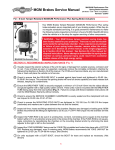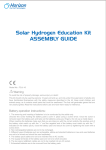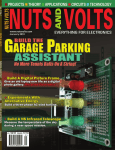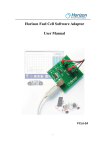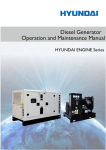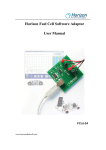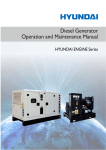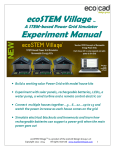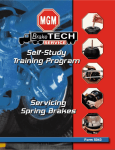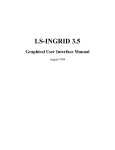Download ExperimentationGuide..
Transcript
Horizon Renewable Energy Education Experiment Manual CREDITS Author: John Gavlik Contributors and Editors: Horizon Education Team Horizon Education and Design Team: Dane Urry, Miro Zhang, Stone Shen Copyright c 2010 by Horizon Fuel Cell Technologies. All rights reserved. No part of this publication may be reproduced or transmitted in any form or by any means, electronic or mechanical, including photocopy, recording, or any information storage and retrieval system, without permission in writing from the publisher. Horizon Fuel Cell Technologies Block 19, No.2 Suide Rd. Shanghai 200331, P.R. China http://www.horizonfuelcell.com Horizon Renewable Energy Education Experiment Manual Contents Experiment Guide Introduction 1-16 Solar Energy Experiments 18-38 Wind Energy Experiments 39-77 Energy from Hydrogen (Fuel Cell) Experiments 78-100 Ultra Cool Experiments 101-140 • Introduction • Adding More Depth to the Experiments • Supporting Information • Grade Level and Subject Appropriateness • Getting Familiar with the Kit • Renewable Energy Monitor • Electrical Components, Circuits, and Terminology • Learning to Correctly Use a Multimeter • Measuring Voltage, Current, Power and Resistance • Ohm’s Law • The WindPitch Educational Wind Turbine • Adapting Other Horizon Products to the Experiments 1. The Effect of Heat on Solar Panels 2. The Effect of Shade on Solar Panels 3. The Effect of Tilt Angle on Solar Panels 4. Finding the Solar Panel’s Maximum Power Point 5. Wind Power - How Many Blades Are Best - 1, 2, 3 ... More? 6. Wind Power - Using Three Different Curved Blade Shapes 7. Wind Power - Using Blades You Make Yourself 8. Wind Power - Turbine Efficiencies 9. Wind Power - Measuring RPM 10. Wind Power -Tuning For Maximum Power 11. Wind Power- To Generate Hydrogen 12. Electrolysis Mode Generating Hydrogen and Oxygen from Water 13. Fuel Cell Mode Generating Electricity from Hydrogen and Oxygen 14. Determining the Minimum Voltage for Water Decomposition 15. Polarization States for Hydrogen Fuel Cells 16. Build a Solar Farm 17. Build a Wind Farm 18. Build a Fuel Cells Stack 19. Running Your School With Hydrogen 20. Running Your School With Solar Power 21. Running Your School With Wind Power About the Author 141 Introduction Renewable Energy Science Education Set The Horizon Renewable Energy Science Education Set p r o v i d e s f o r i n t e r e s t i n g experiments with fuel cells, solar panels and wind turbines. In addition, other electrical components such as resistors, LEDs motors and propellers are used as “loads” for these devices. If you are unsure about the term “load” or what a resistor or LED really is and does, refer to the “Electrical Components and Circuits” section of this manual where you will find a host of useful information on basic electricity concepts and the components used in the experiments. The experiments are sub-divided into functional sections that cover solar panels, stationary fuel cells, a wind turbine and fuel cell car experiments. You don’t have to perform the experiments in any particular order, so feel free to skip around from one to the other as you and your students see fit. In addition to the standard experiments there are some Ultra Cool ones that provide even more excitement and desire to learn on the part of students. Learning math and science using renewable energy will inspire your students to greater goals and achievements. Adding More Depth to the Experiments Each experiment follows a similar outline that not only provides a mechanism for easy performance and an understanding of what to do, it also gives your students the opportunity to expand on the experiment by posing “What If” questions on the experiment just performed. For example: What if - you changed the tilt angle of the solar panel? Will it make any difference in the voltage, current and power outputs? What if - a wind turbine had longer blades? Will it generate more or less power compared to a wind turbine with shorter blades? What if - a fuel cell used pure oxygen instead of plain air? Will it generate more power when it mixed with pure hydrogen? These and other practical and hypothetical questions are posed for each experiment. There are also related research questions that give students the opportunity to go beyond the experimental procedures to discover more about the renewable energy technologies they are studying. Supporting Information The experiments are supported by additional information found in the accompanying publication “Renewable Energy Science Education Manual” that provides an exceptionally rich amount of data, photos and illustrations on the following topics: Chapter 1: The Environment and Climate Change Chapter 2: Solar Energy Chapter 3: Wind Energy Chapter 4: Electrolyzers Chapter 5: Fuel Cells Chapter 6: Hydrogen Storage & Transportation Chapter 7: Basic Power Electronics 1 Cross reference is made between the The experiments can fit into physics, two publications to give you and your chemistry, earth science, life science, and students more complete background on the environmental studies – virtually any subject experimental processes along with sources that deals with energy and the environment. for more research. Look for the highlighted references contained in the two publications. The basis for the experiments is on basic electricity and how solar panels, wind turbines and fuel cells generate and use it. Topics such as Ohm’s Law, electrical power and energy are a continuing theme throughout all of them. If first year algebra is too advanced for younger students there is our Renewable Energy Monitor that measures everything without any calculations and displays it on the classroom computer in full-color graphics (see page 4). For more advanced studies of physics and chemistry the “Renewable Energy Science Education Manual” (at the left) contains numerous examples of advanced theory and math to support any level of technical background necessary for these subjects. Teachers can feel confident in knowing that the experiments and the supporting information comply with the following approved standards: National Science Education Standards (NSES) Grade Level and Subject Appropriateness The experiments are easy to follow and are designed for all middle and high school students, worldwide. Teachers will appreciate the clear, unambiguous instructions for each step of the experimental procedures along with how students are able to quickly comprehend the material. 2 National Science Teachers Association (NSTA) T h e I n t e r n a t i o n a l Te c h n o l o g y Education Association (ITEA) Details of compliance to these standards are found under separate documents outside of this manual. Getting Familiar with the Kit The Horizon Renewable Energy Science Education Set contains four basic devices that you will use for the experiments. These are: • A Solar Panel • A Wind Turbine • PEM Fuel Cell • PEM Electrolyzer Experiment 9: Preparation of the Electrolyzer Module and Wind Powered Hydrogen Production Connect the red and black cables to the corresponding terminals located on the wind turbine and reversible fuel cell. For best results using the WindPitch to generate hydrogen using the included reversible fuel cell, setup the wind turbine hub with six (6) profiled blades supplied with the kit. Use combinations of the BP-28, NCAA 44 or NCAA 63 blades. Set the blade pitch to 15 degrees. Make sure that the wind turbine is generating AT LEAST 1.5 volts. If not, move the wind turbine closer to the fan until it does. Also, make sure that the blade pitch is between 10 and 15 degrees. The wind turbine is sensitive to this setting at high wind speeds. Allow the table fan and wind turbine to run for 10 minutes on high wind speed setting to generate sufficient amounts of hydrogen and oxygen gases that are stored in the water/gas tanks. EXPERIMENT 9 Experiments are designed around these three renewable energy devices. You will find complete information on the assembly and use of these devices in a separate document entitled: Battery Pack If the wind is sufficient the system will now start to produce hydrogen and oxygen in the respective cylinders. When bubbles begin to surface in the hydrogen cylinder the cycle is complete. Disconnect the reversible fuel cell from the Wind Turbine. Procedure for repeated gas production: Disconnect the small plugs from the tubes connected to the nozzles on the reversible fuel cell. This will allow water into the inner cylinders to replace the gasses and reset water levels to “0” line. Re-insert the plugs into the tubes and repeat electrolysis again. Note: You may also use the battery pack to perform electrolysis (In the case of no wind source) Please remove the screw from cover of battery box using a screw driver. Push and slide the cover and open the battery box. Try NOT to touch the cables when you open the cover. Place two AA batteries as indicated. Push and slide the battery box cover to closed position and screw fightly into place using screw driver. Renewable Energy Education Set ASSEMBLY GUIDE EXPERIMENT 10 Experiment 10(alternative): Using the Battery Pack to Perform Electrolysis (in the case of no sun or wind) Push and slide open the cover Remove the screw from the cover AA ry tte Ba AA r tte Ba y Make sure the switch on the battery box is in the "off" position before you place the batteries into the box. WARNING: If the cable is short circuited the batteries inside could become hot and potentially cause burns, melting of parts, or create risk of fire. Note: Battery’s energy may be consumed after 4-5 times of use. 6 YOU ARE STRONGLY ENCOURAGED to read and understand this information before Experiment 3: Preparation of the Electrolyzer Module and Solar Powered Hydrogen Production proceeding with the experiments. Here are Insert the electrolyzer, terminals on top, into the slot on the base. Cut 2 x 4cm length pieces of rubber tube and insert a black pin into the end of one tube. Place the tube with the black pin into the top pin on the hydrogen side (with black terminal). Place the other tube firmly onto the top input nozzle on the oxygen side. samples of the information presented. Renewable Energy Education Set What do you need? REES ASSEMBLY MAP AA batteries=2 Units Water=25ml Scissors For more detailed description of experimentation possible with this kit refer to the manual provided on CD-ROM. IMPORTANT: Use common sense when connecting the parts described in this guide. Improper connections can cause failure and permanent damage to your equipment. Experiment 1: Use a Solar Panel to Power the LED Module Connect the cables to the solar cell/panel and circuit board to power LED module as shown. Make sure black and red cables are used with the red and black terminals respectively. Fill the syringe with DISTILED water. On the red oxygen side of the electrolyzer, connect the syringe to the uncapped tube. Fill the electrolyzer until water begins to flow out of the tube. Attach a red plug to the Oxygen side tube. Let settle for 3 min. Attach the round cylinders to the cylinder base and insert the inner cylinders into the outer ones. Make sure the plastic rims do not cover the openings located on the bottom of the inner cylinders. Cut out a 16cm length tube. Place it through the holes on the white clincher, with the clincher 4 cm from the end of the tube. Connect the long end of the tube to the inner hydrogen cylinder. Connect the other end of the tube to the bottom end of the black hydrogen side of the electrolyzer. Connect a 16cm length of tube to the inner oxygen cylinder and then to the red oxygen side of the electrolyzer. Pour 20ml water into each cylinder. Disconnect the red pin from the tube on the electrolyzer. The water should fill the inner container, then reconnect the red pin. Repeat on the Hydrogen side. Connect the electrolyzer to the solar panel using the corresponding cables and expose to direct sunlight. (Important: make sure connections are correct or permanent damage can occur. Make sure the clincher is OPEN.) The system will now start to produce oxygen and hydrogen in the respective cylinders. When bubbles begin to surface in the cylinder the cycle is complete. Disconnect the electrolyzer. EXPERIMENT 3 EXPERIMENT 1 Experiment 2: Use a Solar Panel to Power a Small Fan and a Small Car Wheel Module Assembly of the small electric fan: Connect small round white adapter to the motor axis. Connect the fan blade to the adapter. Assembly of the car wheel: Firmly connect the other (tapered) white adapter to the motor axis. Attach the small wheel to the adapter. Connect the solar panel to the circuit board then to the motor base as shown. The fan may need to be flicked with your finger to start. EXPERIMENT 2 3 Renewable Energy Monitor (Optional- not included) Use it with or Without a Computer Horizon has developed the Renewable The Renewable Energy Monitor can be used Energy Monitor to enhance your study of with or without a computer – indoors or out – renewable energy. The following is provided and it works with all Horizon solar, wind and fuel as a quick guide to its features and operation. cell products. For complete details refer to the Renewable where they perform best – outdoors – and Energy Monitor User Manual that comes with it. measure all the data there. Main Features With the USB interface the Renewable Energy Do solar and wind experiments Monitor plugs directly into your computer. The computer displays real-time plots of actual measurements that give students a visual understanding of what’s going on. LCD Screen The LCD screen displays all the data at once without moving wire probes like on a multimeter. And students can switch between screens with The Renewable Energy Monitor provides complete measurement and display functions for all the experiments; plus, it can be used as a general purpose meter instead of a multimeter for your electrical measurements. And it does it automatically – no computations!! Example Computer Plot of Voltage, Current, Power and Resistance 4 just a push of a button. Horizon has made the complicated simple – and powerful – so that you and your students spend more time experimenting and less time figuring out how to hook things up. Electrical Components, Circuits and Terminology The following information will help you to understand some of the components, circuits and terminology used in the experiments. Each is presented in the form of a question. What is Current? Electrical current is to electricity as the volume of water is to water flow. A fire hose can carry more water at higher pressure compared with a clogged shower head. So too can lager wires carry more current as compared with smaller wires. What is Voltage? Voltage is to electricity as pressure is to water; both are forces that move things. Voltage is the force that moves electrons through a circuit; the greater the voltage the greater the force of electron movement. Voltage is generated by creating a “potential difference” between positive and negative elements of the device generating it. Electrical current carries electrons along a path (called a circuit) like water carries water molecules through a hose. More electrons mean more current flow. Water normally flows from upstream to downstream using gravity as a force. Electrical current normally flows from positive (+) to negative (-), which is called direct current or DC for short, but gravity is not involved. Like water, the higher the voltage, the more force it exerts. Water falling from a height uses gravity to create force; the higher the water falls (its potential difference), the more force or pressure it creates. Unlike water, however, voltage is not created by gravity but by chemical, optical, or magnetic forces. Batteries use chemicals to generate voltage while common fuel cells use electrons in hydrogen gas to create voltage. Solar panels use optical means to capture the sun’s photons to do the same and wind turbines use rotating magnets that are very close to coils of wire that generate voltage based on the magnetic fields created by the magnet’s rotation. Unlike water, electrical current can flow in either direction – positive to negative and negative to positive. The latter is usually called alternating current, or AC, since the current switches (alternates) between positive and negative directions. Electrical current produced by batteries are DC while electrical current coming out of the wall socket is AC. Both have their applications in electronic circuits. Current is measured in units called amperes or amps Voltage is measured in units called volts 5 What is a Resistance? What is a Resistor? A potentiometer is a variable resistor much like the knob on your car radio. You adjust it for various resistance values. The potentiometer supplied with the kit can be adjusted from 100 to 0 ohms. The two round connectors allow you to plug it into any of the experimental circuits with the supplied wires. A resistor is a passive electrical device usually composed of a material like carbon that limits the flow of current from a power source. Resistors are normally considered as loads and are important components in any electrical circuit. The physical part and electrical symbol for a resistor are shown below. This is a kind of “fixed value” resistor because it has only one resistance value. Larger wires can carry more electrical current as compared with smaller wires. In electrical circuit boards, components called resistors are inserted in the circuit to limit current flow. The resistance to the flow of electrons depends on the type and size of the materials used. While water flowing in a pipe does not generally produce heat by itself, electrical resistive materials produce varying degrees of heat created by the flow of electrons through the material. Heat is generally considered wasted energy (as in a hot light bulb) but not always, as in a toaster or hair dryer where heat from resistance is the desired quantity. Resistance is measured in units called ohms. 6 A resistor’s value is specified in ohms What is a Potentiometer? A potentiometer is a variable resistor much like the knob on your car radio. You adjust it for various resistance values. It has three terminals – left, center and right. Horizon has made it simple to use with a dial that shows resistance from 100 to 0 ohms. What is a Power Source? What is a Load? An electrical power source A load is a device that absorbs the power is a device that produces coming from a power source and uses the electrical voltage and current power to do work, like spin a motor, or simply and power. Power sources dissipate the power into heat like the coils of can use chemical energy like wire in a toaster. In all cases, loads are used a battery or fuel cell, solar to both consume and regulate the power energy like a solar panel or being produced. Generally speaking, a load wind energy coupled with is measured as resistance in units called magnetic energy such as a ohms. wind turbine. Each of these Very Heavy Load power sources converts one kind of energy (chemical, light or mechanical) to electrical energy. Heavy Load Light Load 100 ohms 10 ohms 1 ohm The equation for electrical power is shown below: P = V * I where P = Power in watts V = Voltage in volts I = Current in amps In relative terms, a “light” load has a large resistance and a “heavy” load has a small resistance. This may be counter intuitive, but it is the case, nevertheless. For example, a 100 ohm resistor presents a “lighter” load to What is a Circuit? A circuit is any “unbroken” or closed connection of electrical components that form a continuous conducting path for current to flow; if the circuit is “broken” (or open as in a circuit as compared with a 10 ohm resistor. The illustration below shows the relative electrical “weight” of three typical resistor loads. The fuel cell and motor-propeller are each about 2 to 4 ohms making them a very heavy load. an open circuit) no current can flow and no power or energy can be delivered. The most basic electrical circuit is made up of a power source (like a battery shown here) attached to a load (like a resistor shown here). 7 What is a Series Circuit? What is a Parallel Circuit? In an electrical circuit several devices such as light bulbs can be placed in a line - or in series - between the positive and negative poles of the battery. This is called a series circuit. Devices can be arranged in a parallel circuit such that if any bulbs burn out the circuit still remains intact and operates. Holiday lights are wired in parallel so that if one bulb burns out the others remain lit. A major problem is if one light bulb burns out, then it acts like a switch and turns off the whole circuit. On the other hand a major advantage of a series circuit is that it saves wires that are needed in a parallel circuit. The circuit below shows two lights wired in parallel. If one light burns out the other one stays on. What is Power? What is Energy? Power is the combination of voltage and current. Voltage is the pressure component of power forcing electrons to move through a circuit, and current is the quantity component of power indicating the amount of electrons in the flow. Both voltage and current are required to produce the electrical force called power. Power is instantaneous and is not measured over time like energy. When you measure power, you measure voltage and current for a given instant of time. This is an important distinction – time, or lack of it, is the essential difference between power and energy. Power is instantaneous while energy is power measured over time. Electrical power is measured in units called watts. 8 Energy is power over time. Energy is the power flowing through a circuit for a given time like one second, one minute or one hour. When we speak of energy we mean power times time. Energy is measured in units similar to power but with a time component as in watt-seconds (or Joules), watt-minutes or watt-hours. If a circuit generates 1 watt of power for 1 hour, it is said to generate 1 Watt-Hour of energy. Your electric meter measures power in WattHours (3600 Joules), but that can be converted to any other time frame by understanding how time is measured – one hour = 3600 seconds. Energy is measured in Joules (wattseconds) in the experiments. Learning to Correctly Use A Multimeter A multimeter combines measuring voltage, current and resistance into a single instrument. While somewhat intimidating for first time users there are a few simple and effective ways to make these measurements for the experiments. This section shows you how. Manual For safety reasons DO NOT connect a multimeter to the 110 VAC wall socket or to electrical appliances that are plugged in to it. Auto A Simple Circuit Selecting the right multimeter dial position is just the start. To correctly measure voltage, current and resistance the Types of Digital Multimeters There are basically two types of digital multimeters – manual (left) and auto ranging (right). As you can see the manual model on the left has more dial positions, so you have to be careful to select the right one for your measurement. The auto ranging type on the right, which is usually more expensive, does most of the work for you. All you need to do is select the desired function like voltage, current or resistance and it makes the measurement at the proper scale. However, for both meters you need to know how to correctly attach the leads for multimeter leads must be inserted into the circuit in the correct manner. As an example we will start with a simple but typical circuit to see how each of these measurements is made. This one is composed of a solar panel as the voltage source and a resistor as the load. Other circuits will include fuel cells, motors and other components; however, the technique for measurement is essentially the same. Let’s start with the easiest measurement and progress to the more difficult ones. the measurement. 9 Measuring Voltage Measuring Current To measure voltage: To measure current the circuit must be • Set the dial to the proper DC (direct “interrupted” or “broken” and the multimeter current) voltage range (V) must be placed in series with the circuit. • Connect the red lead to the positive Notice that you may need extra clip leads to (+) side of the part to be measured attach the parts of the circuit together. • Connect the black COM lead to the • Set the dial to the proper DC (direct negative (-) side to be measured current) current range usually in A or • Read the voltage on the display ma or milliamps • Connect the red lead to the positive (+) side of the voltage source (the solar panel in this example) • Connect a clip lead from the negative (-) side of the voltage source to one side of the resistor • Connect the black COM lead to the other side of the resistor • Read the current on the display See Ohm’s Law below for an easier way to determine current without disturbing the circuit 10 If you have two of the three quantities Measuring Resistance already measured you can compute the third. In order to measure the resistance of a component at least one side of the component must be free and away from the circuit. For best results both sides should be free of the circuit. • Set the dial to resistance - normally shown with the omega ( ) symbol. • Connect the red lead to one end of the resistor • Connect the black COM lead to the other end of the resistor • Read the resistance in ohms on the display For example if you measured current and resistance you can calculate voltage by the following equation: V=I*R If you have voltage and current, you can compute resistance: R=V/I And if you know the voltage and resistance you can compute current: I = V / R (see below for computing current) Use these simple and direct equations in the experiment – especially the one for computing current with voltage and resistance, since it makes for a much easier measurement sequence without having to interrupt or break the circuit. If you know the resistance value then computing current like that shown above is a snap. If you don’t know the resistance value (like using a motor for a load) you still have to use the conventional way to measure current. Ohm’s Law The multimeter measurements form the basis for some basic electrical computations referred to as Ohm’s Law after the German physicist Georg Ohm, who, in 1827, described measuring voltage and current through simple electrical circuits containing various lengths of wire. The mathematical basis for Ohm’s Law can be stated as: • • • V = I * R where V = voltage in volts I = current in amps R = resistance in ohms Computing Current Is As Simple As 1, 2, 3 In order to quickly compute current using Ohm’s Law with a known resistance and voltage see the examples below: Examples: 1. Resistor = 100 ohms 2. Voltage = 1 volt 3. Current = 1 / 100 = 0.010 amps = 10 milliamps 1. Resistor = 10 ohms 2. Voltage = 1 volt 3. Current = 1 / 10 = 0.100 amps = 100 milliamps 11 1. Resistor = 50 ohms 2. Voltage = 1 volt 3. Current = 1 / 50 = 0.020 amps = 20 milliamps 1. Resistor = 5 ohms 2. Voltage = 1 volt 3. Current = 1 / 5 = 0.200 amps = 200 M ea su rem en ts wi th the Renewable Energy Monitor - with no calculations! milliamps Computing Power You can compute power using voltage, current and resistance. The equation for power is: P = V * I where • P = power in watts • V = voltage in volts • I = current in amps If you have the measurements for voltage and current – or if you can compute current from voltage and resistance – then use the above equation to compute power. If you have the measurements for voltage and resistance but not current, you can use the following equation by substituting the equation for resistance: P=V*I P = V * (V / R) P = (V * V) / R P = V2 / R Examples: 12 1. Voltage = 1 volt 2. Current = 20 milliamps 3. Power = 1 x 20 = 20 milliwatts 1. Voltage = 4 volts 2. Resistance = 100 ohms 3. Power = (4 * 4) / 100 = 16 / 100 = 0.016 watts = 16 milliwatts Instead of using a multimeter with its complicated dial and hookups Horizon developed the Renewable Energy Monitor to allow you to directly measure and display voltage, current, power, resistance, energy and RPM directly and without computations. Simply attach the Renewable Energy Monitor to a solar panel, fuel cell or wind turbine and read the measurements on the large LCD screen. That’s it! There’s nothing more to do…except attach it to your classroom computer for even more exciting visual measurements. And its battery powered so you can use it anywhere – indoors or out. The WindPitch Wind Turbine Using the Right Fan The WindPitch wind turbine is an important To g e t t h e b e s t p e r f o r m a n c e f r o m t h e component of the Renewable Energy WindPitch you must use the right fan. Here Education Set. With it you can add from two is a photo of the best kind of fan to use. It’s to six blades of different shapes as well as at least 20 inches in diameter with at least 3 make your own. And the blades are made speed settings. to aircraft standards just like real airplane propellers. You can even adjust the pitch or angle of the blades to get the most power from the wind. This is a powerful and practical experimental tool that teaches a great deal about how actual wind turbines work. An entire section of this Experiment Manual is dedicated to the WindPitch. There are experiments for: • Measuring RPM • Wind Turbine Efficiencies • Tuning for Maximum Power • Adding from Two to Six Blades • Adjusting Blade Pitch • And more… Don’t skimp on a small table fan – it won’t work as well and your experiments will not have the desired results. Use a big fan that produces lots of wind. 13 Adapting Other Horizon Products to the Experiments Besides the Renewable Energy Science Education Set Horizon makes several other products that can benefit from the experiments presented here. These include: • Solar Hydrogen Education Kit • Hydro-Wind Kit • Hydrocar Education Kit • Fuel Cell Car Science Kit • WindPitch Education Kit Adapting For Electrolysis Where it is necessary to measure the voltage (V) and current (I), pull out the metal parts of both banana plugs “part way” to expose them to the multimeter leads (not necessary if using the Software Adaptor). Make sure to keep them partially plugged into the red and black terminals on the reversible fuel cell. The balance of the electrolysis cycle is essentially the same as in the experiments. These products use a reversible fuel cell while the experiments are designed for separate electrolyzers and non-reversible fuel cells. They can be easily adapted to the experiments by using the equivalent setups shown below. The next pages provide lists of existing experiments that can be done with them. 14 Adapting For Fuel Cells Since these products use a reversible fuel cell rather than an electrolyzer (be careful – they look alike), there is no reason to use a separate fuel cell when the experiment calls for one. Rather, the reversible fuel cell will do the same task. Follow the same general procedures for the hookup leads as in doing electrolysis. You will be substituting individual resistor for the motor-fan in some of the experiments. 15 The Effect of Shade on Solar Panels LEARNING OUTCOMES Students are shown that shade from trees, clouds and man made objects can cause a disproportionate decrease in power output and can even cause physical damage to a solar panel. Students come to understand that: 1. Shade is like turning off an internal power switch that shuts off most of the power to the rest of the solar panel. 2. Solar panels can be damaged by shade if they do not have the appropriate internal protection. 3. Solar panels on space satellites must always be repositioned as they travel in orbit around the Earth. STUDENT ACTIVITIES LESSON OVERVIEW This lesson demonstrates how a solar panel looses much of its power when even a small part of it is shaded. Students study the effect of shade on a solar panel by first placing it in direct light without any shade. Then the entire solar panel is shaded by placing a sheet of facial tissue between the light source and the panel to simulate overcast. The tissue is removed LESSON OBJECTIVES • Students will use the Scientific Process to perform the experiment. • Students will collect and analyze data. • Students will observe the photovoltaic effect of sunlight and artificial light producing electricity. • Students will learn how both overcast and shade affect solar panels. • Students will use the Internet to research lesson related topics. and then only a small portion of the solar panel is shaded with an opaque object like a regular piece of paper while the rest of the panel is fully illuminated. For each trial students measure the solar panel’s voltage, current and power levels in order to perform later analysis. SAFETY Normal caution must be exercised when using an artificial light source like a table lamp to illuminate a solar panel. Be sure NOT to overheat the solar panel as it will become HOT TO THE TOUCH and may MELT THE PLASTIC. 22 The Experiment with a Multimeter in order to shade the entire panel but have Materials were an overcast day. enough low light shining on the panel as if it 6. Record the voltage. 7. Remove the facial tissue. 1 - Solar panel 8. Apply a regular piece of paper directly over 1 - Goose neck table lamp one fourth ( ¼ ) of the solar panel to cover 1 - 100 ohm potentiometer that portion completely. Refer to Figure 1. 2 – Red hookup lead 9. Record the voltage. 2 – Black hookup lead 1 – Circuit Board Module Base Equipment Setup Figure 1 – Paper Shading ¼ Solar Panel Doing the Experiment Caution: Do not overheat the solar panel or touch it if it becomes hot! 1. Set the potentiometer to 10 ohms. 2. Set the multimeter dial to DC Volts with a range of at least 5 VDC. 3. Set the table lamp above the solar panel and turn on the light – or place the panel in direct sunlight which is best. Preparing the Data Have the students enter the voltage readings in the table below. Have them compute the current and power based on the 10 ohm resistor load. Refer to the Experiment Guide section for details on how to do this. Step Full light Overcast Shading Volts Amps Watts 4. Record the voltage. 5. Place a single sheet of facial tissue between the light source and the solar panel 23 The Experiment with the Renewable Energy Monitor this to occur. Materials 5. 1 - Solar panel in direct sunlight which is best. 1 - Goose neck table lamp 6. Record the voltage, current and power. 1 - 100 ohm potentiometer 7. Place a single sheet of facial tissue 2 – Red hookup leads between the light source and the solar panel 2 – Black hookup leads in order to shade the entire panel but have 4. Push the Select Button until the Volts Amps Watts display appears. Set the table lamp above the solar panel and turn on the light – or place the panel enough low light shining on the panel as if it Equipment Setup were an overcast day. 8. Record the voltage, current and power. 9. Remove the facial tissue. 10. Apply a regular piece of paper directly over one fourth ( ¼ ) of the solar panel to cover that portion completely. Refer to Figure 2. 11. Record the voltage, current and power. Doing the Experiment Caution: Do not overheat the solar panel or touch it if it becomes hot! 1. Set the Renewable Energy Monitor switch to Battery or Computer depending on your hookup. 2. Push the Select Button until the Ohms display appears. Figure 2 – Paper Shading ¼ Solar Panel Preparing the Data Have the students enter the voltage, current 3. Adjust the potentiometer for 10 ohms. Light must be shining on the solar panels for 24 and power data into the table below: Step Volts Amps Watts Full light Overcast Shading Wind Power How Many Blades Are Best - 1, 2, 3... More ? LEARNING OUTCOMES Students witness how two, three, four and six blades produce varying amounts of power for the same wind speed. Students come to understand that: 1. Adding more blades may, or may not, generate more power. 2. Adding more blades creates more “drag” caused by increased wind resistance. Using the right number of blades for a given 3. Reducing the number of blades may wind condition is important in extracting result in higher output power. the maximum electrical power from a wind 4. turbine. In this experiment students gain an with more blades. The wind turbine will run smoother understanding of the choices between the numbers of blades that are necessary to produce the most power. STUDENT ACTIVITIES Students select from the three types of curved blades supplied for the model wind LESSON OBJECTIVES turbine. They start with two blades attached • Students will use the Scientific turbine’s power output at the highest fan Process to perform the experiment. speed setting. They add additional blades • Students will collect and analyze data. and repeat the experiment until the final • Students will learn to use a model number of blades equals six. They then wind turbine that generates a analyze the results of the power generated safe level of DC electricity. to determine the optimum number of blades • Students will learn about how different that produce the maximum power output. numbers of blades produce different Students are free to mix and match from the power outputs from the wind turbine. three different blade types supplied with the • Students will use the Internet to wind turbine. research lesson related topics. to the hub and measure and record the wind SAFETY Be sure NOT to touch the spinning blades as potential injury may result. Also, be sure to wear safety glasses at all times to protect eyes from injury. 39 The Experiment with a Multimeter Note: You may mix and match any of the Materials sure to arrange the blades on the hub so that 1 – WindPitch Wind Turbine make sure that you keep the pitch angle the 1- Table fan (20” diameter recommended) same for each test; the wind turbine is very 1 - 100 ohm potentiometer sensitive to it. blades that come with the wind turbine. Make they are symmetrical and balanced. Also 6 – Curved blades 2 – Red hookup lead 1. Adjust the potentiometer dial to 75 2 – Black hookup lead ohms. 1 – Circuit Board Module Base 2. Set the multimeter dial to Volts with a range of at least 10 volts. Wind Turbine Blades 3. To begin, install two (2) blades of any type on its highest speed setting. the wind turbine hub and attach the hub to 4. Measure the voltage. the alternator shaft. Refer to the WindPitch 5. Repeat step 4 with 3 blades Assembly Guide for instructions on how to 6. Repeat step 4 with 4 blades do this. You will add more blades later. 7. Repeat step 4 with 6 blades Equipment Setup Place the table fan in front of the wind turbine about 2 feet away from it and set it to Preparing the Data Have the students enter the voltage readings in the table below. Then have them compute the current and power based on the 75 ohm resistor load for each step. Refer to the Experiment Guide section for details on how to do this. Listed below is an example of our experiment. Our Data Doing the Experiment Caution: Be careful not to touch the spinning blades and wear safety glasses to prevent eye injury! 40 Blades 2 3 4 6 Your Data Blades 2 3 4 6 Resistance=75 ohms Volts 6.160 6.528 6.375 6.639 Amps 0.083 0.088 0.086 0.089 Watts 0.511 0.574 0.548 0.591 Resistance=75 ohms Volts Amps Watts The Experiment with the Renewable Energy Monitor they are symmetrical and balanced. Also Materials sensitive to it. 1 – WindPitch Wind Turbine 1. 1 – Table fan (20” diameter recommended) switch to Battery or Computer depending on 1 – 100 ohm potentiometer your hookup. 6 – Curved blades 2. 2 – Red hookup lead mA-mW display appears. make sure that you keep the pitch angle the same for each test; the wind turbine is very Set the Renewable Energy Monitor Push the Select Button until the mV- 2 – Black hookup lead 1 – Circuit Board Module Base Wind Turbine Blades To begin, install two (2) blades of any type on 3. Place the table fan directly in front of the wind turbine hub and attach the hub to the wind turbine about 2 feet away from it and the alternator shaft. Refer to the WindPitch set it to its highest speed setting. Assembly Guide for instructions on how to 4. do this. You will add more blades later. until the maximum power in mW is displayed. Adjust the 100 ohm potentiometer 5. Record the voltage, current and power. Equipment Setup Computer is Optional 6. Repeat step 5 with 3 blades. 7. Repeat step 5 with 4 blades. 8. Repeat step 5 with 6 blades. Preparing the Data Listed below is an example of our experiment. Our Data Doing the Experiment Caution: Be careful not to touch the spinning blades and wear safety glasses to prevent eye injury! Note: You may mix and match any of the blades that come with the wind turbine. Make Blades 2 3 4 6 mV 6160 6528 6375 6639 mA 83 88 86 89 mW 511 574 548 591 mV mA mW Your Data Blades 2 3 4 6 sure to arrange the blades on the hub so that 41 Guide for Making Custom Blades 6. Designing and cutting out custom blades are more customized and attractive. The including the wind vane from sheet plastic is following are some examples of custom a fun thing for students to do. However, they blades, but use your imagination – the sky’s must be made aware of the following practical the limit – just make sure to follow the rules issues to be successful – and safe! outlined above. to color or paint the blades so that they 7. 1. The blades can be made from any paper materials such as construction paper For more fun allow the students Give your blades a name so that you can tell which ones you used for each experiment. or cardboard paper that is rigid enough to withstand the wind and not bend too easily. First draw out the basic shape on a sheet Examples of Custom Blades of paper. Then cut it out and use it as a template over the actual cardboard paper or Here are some examples of the kinds of other material to make the actual blades. blades that you can make yourself. Make 2. sure to create both long and short blades with Use scissors and a hole punch to cut the blades to the shape you want. 3. some narrow and some wide. The blades must be cut so that they are balanced or else the wind turbine will not spin properly. 4. Important - The blades must also be made so that they don’t fly apart or break when spinning. This creates a dangerous safety hazard. Always have students wear safety goggles when any of the blades are spinning. 5. Each blade must be able to fit into the hub provided. This means that the bottom end of each blade must conform to the template below. The rest of the blade can be any shape as long as it meets the requirements of steps 1 through 4 above. Your wind turbine came with three flat blades so use this end as a guide for making your own. 51 F uel Cell Mode - Generating Electricity from Hydrogen and Oxygen LEARNING OUTCOMES Students are shown that the hydrogen and oxygen produced in the experiment entitled “Electrolysis Mode – Generating Hydrogen and Oxygen from Water” can now be recombined to generate DC electricity to drive a small electric motor. Students come to understand that: 1. A fuel cell is like a battery that supplies voltage and current into a load as long as a supply of hydrogen and oxygen are available. 2. Fuel cells can operate with other substances besides hydrogen and oxygen including alkaline and methanol. LESSON OVERVIEW 3. The choice of fuel cell electrolyte This lesson demonstrates how a fuel which it is intended. material is dependent on the application for cell generates electricity from combining hydrogen and oxygen. The Fuel Cell Mode as it is called is just the reverse of the STUDENT ACTIVITIES Electrolysis Mode where water is split into Students produce a sufficient quantity of hydrogen and oxygen. In the Fuel Cell mode hydrogen and oxygen via an electrolyzer then the hydrogen and oxygen are recombined to allow the fuel cell to recombine these gasses create electricity. to generate electricity. An electric motor is used to consume the electricity. Power from the fuel cell is measured with the motor just LESSON OBJECTIVES free-spinning and with it connected to a • Students will use the Scientific analyzed to determine the loading effect of Process to perform the experiment. the propeller. • Students will collect and analyze data. • Students will learn to use a reversible PEM fuel cell in the fuel cell mode. • Students will learn the principles of Be sure to wear safety glasses at all times to generating DC electricity with a fuel cell. protect eyes from injury. • Students will learn to calculate energy. • Students will use the Internet to research lesson related topics. propeller as a load. Data are taken and later SAFETY 83 The Experiment with a Multimeter Equipment Setup #2 Materials 1 – Battery Pack (3 volt battery with switch) 1 – Electrolyzer apparatus 1 – Fuel cell 1 – Motor and propeller 2 – Red hookup leads 2 – Black hookup leads 1 – Circuit Board Module Base 1 – Fuel Cell Base 1 – Electrolyzer Base Equipment Setup #1 6. With the motor shaft free spinning record the voltage and current. You will need to place the multimeter in both parallel (voltage) and series (current) wiring configurations for this step. Refer to the Experiment Guide for help. 7. Apply the propeller to the motor shaft and record the voltage and current again. Preparing the Data Have the students enter the voltage and Doing the Experiment 1. Set the multimeter dial to DC Volts with a range of at least 5 VDC. 2. Fill both the hydrogen and oxygen cylinders to the 0ml marks with distilled water. Make sure that the inner containers completely fill with water. 3. Set the ON-OFF switch on the battery pack to ON. 4. Set the battery switch to OFF when the water in the hydrogen cylinder reaches the 10ml mark. 5. Switch to Equipment Setup #2. Take care to maintain the hydrogen and oxygen supplies by following the directions in the Experiment Guide. 84 current readings in the table below. Have them compute the power based on the recorded voltage and current. Refer to the Experiment Guide section for details on how to do this. As an example we entered our data. Our Data No Prop With Prop Volts 0.757 0.630 Amps 0.165 0.339 Watts 0.125 0.214 Volts Amps Watts Your Data No Prop With Prop The Experiment with the Renewable Energy Monitor Materials 1 – Battery Pack (3 volt battery with switch) 1 – Electrolyzer apparatus 1 – Fuel cell 1 – Motor and propeller 2 – Red hookup leads 2 – Black hookup leads 1 – Circuit Board Module Base 1 – Fuel Cell Base 1 – Electrolyzer Base 5. Set the battery switch to OFF when the water in the hydrogen cylinder reaches the 10ml mark. 6. Switch to Equipment Setup #2. Take care to maintain the hydrogen and oxygen supplies by following the directions in the Experiment Guide. Equipment Setup #2 Equipment Setup #1 7. With the motor shaft free spinning record the voltage, current and power. 8. Apply the propeller to the motor shaft and record the voltage, current and power again. Doing the Experiment 1. Set the Renewable Energy Monitor switch to Battery or Computer depending on your hookup. 2. Push the Select Button until the mVmA-mW display appears Preparing the Data Have the students enter the voltage, current and power into the table below. Our Data No Prop With Prop Volts 0.757 0.630 Amps 0.165 0.339 Watts 0.125 0.214 Volts Amps Watts Your Data 3. Fill both the hydrogen and oxygen cylinders to the 0ml marks with distilled water. Make sure that the inner containers completely fill with water. 4. Set the ON-OFF switch on the battery pack to ON. No Prop With Prop 85 Build a Fuel Cell Stack LEARNING OUTCOMES Students are shown that the fuel cells can be arranged in series and parallel configurations to produce the desired levels of voltage and current outputs. Students come to understand that: 1. Fuel cells in series generate more voltage with the same amount of current. 2. LESSON OVERVIEW This lesson demonstrates methods to arrange two PEM fuel cells in series and Fuel cells in parallel generate more current with the same amount of voltage. 3. The energy used to drive a motor- propeller load with fuel cells in parallel is different than with fuel cells in series. parallel configurations in order to study the voltage, current and power generated. It is designed to be a simulation of a commercial fuel cell stack in model scale where students learn the potential of fuel cells as substitute for rechargeable batteries in both home and industrial applications. STUDENT ACTIVITIES Students first electrolyze “two” 10 ml water units into hydrogen and oxygen using” two separate electrolyzer apparatus” and in doing so they measure the voltage, current, power and time in order to compute input energy. LESSON OBJECTIVES • Students will use the Scientific Process to perform the experiment. • Students will collect and analyze data. • Students will learn how to wire fuel cells in series and parallel. • Students learn to compute energy. • Students will use the Internet to research lesson related topics. They then wire two fuel cells in series and connect a motor-propeller to the fuel cells to see how long the motor-propeller can spin. This is followed by electrolyzing water again and wiring the same fuel cells in parallel and repeating the measurements. Data are taken at each step for later analysis. SAFETY Be sure to wear safety glasses at all times to protect eyes from injury. 123 The Experiment with a Multimeter cylinders to the 0ml marks with distilled Materials are completely filled with water. 2 – Fuel Cells pack to ON. 2 – Battery Pack (3 volt battery with switch) 5. 1 – Motor and propeller to begin timing how long it takes for the 1 – Clock, watch or stopwatch hydrogen to fill to the 10ml level on the 2 – Electrolyzer unit with gas storage containers hydrogen cylinder. 3 – Red hookup leads 6. 3 – Black hookup leads this is happening. You will need to place 1 – Circuit Board Module Base the multimeter in both parallel (voltage) and 2 – Fuel Cell Base series (current) wiring configurations for this 4– Red hookup leads step. Refer to the Experiment Guide for help. 4 – Black hookup leads 7. water. Make sure that the inner containers 4. Set the ON-OFF switch on the battery Note the time on the clock or watch Record the voltage and current as Set the battery switch to OFF when the hydrogen cylinder reaches the 10ml mark. Equipment Setup #1 – Electrolyzing Water 8. Note the time it took to create this level of hydrogen and enter it into the table below. Convert this time into seconds. 9. Repeat steps 1 through 8 for the other electrolyzer apparatus. Preparing the Data Have the students enter the time, voltage and current readings in the table below. Have them compute the power based on the recorded voltage and current. Refer to the Experiment Guide section for details on how to do this. As an example we entered our data. Doing the Experiment Part 1: 1. Setup the equipment as in Equipment Setup #1. 2. Set the multimeter dial to DC Volts with a range of at least 5 VDC. 3. 124 Fill both the hydrogen and oxygen Part 1 - Our Data Seconds Volts EL 1 175 2.227 EL 2 194 2.202 Part 1 - Your Data Seconds Volts EL 1 EL 2 Amps 0.594 0.551 Watts 1.348 1.113 Amps Watts The Experiment with a Multimeter Equipment Setup #2 – Measuring the Time and Energy Used to Power a Motor-Propeller with Fuel Cells in Series Part 2: 10. Setup the equipment as in Equipment Setup #2. Be sure not to release any of the 15. Subtract the start time in step 11 from the stop time in step 14 and convert this time stored hydrogen and oxygen to the air. Refer into seconds. to the Experiment Guide for details. Preparing the Data 11. Connect the red wire from the fuel cell to the Circuit Board Module Base and note Have the students enter the time, voltage the time on the clock or watch. If the motor and current readings in the table below. doesn’t immediately start spinning, give the Have them compute the power based on the blade a push with your finger being careful recorded voltage and current. Refer to the not to allow the rotating blade to cause injury. Experiment Guide section for details on 12. how to do this. Record the voltage and current as this is happening. You will need to place the multimeter in both parallel (voltage) and series (current) wiring configurations for this step. Refer to the Experiment Guide for help. 13. Allow the motor to run until the Part 2 - Our Data Seconds Volts Part 2 90 1.041 Amps 0.560 Watts 0.580 Parts 2 - Your Data Seconds Volts Amps Watts hydrogen is used up. 14. Note the time when the motor- propeller stops turning. Proceed to Part 3 of the experiment on the following page. 125 About the Author John Gavlik is the founder and president of LearnOnLine, Inc., (www.learnonline.com) a company dedicated to promoting the application of online teaching and learning to the mediums of the Internet and World Wide Web. Mr. Gavlik is a degreed electronic engineer who, with his technical training, early on recognized the potential of these new mediums for effective distance education. This is especially true in the case of collaborative learning that involves individuals and groups that are geographically separated. One such collaborative project is the Renewable Energy Education Lab, or REEL Power, which uses renewable energy devices such as solar panels, wind turbines and fuel cells to help teach math and science. Designed by Mr. Gavlik, REEL Power provides students and teachers with both classroom and Internetbased teaching aids that allow them to do experiments in class and reach out to other schools, worldwide, to share their activities using YouTube, Skype, Twitter, Google Earth and other Internet tools. Mr. Gavlik’s other professional work experience includes over 35 years of digital hardware, software and embedded firmware design for leading commercial and aerospace companies including Bendix Electrodynamics, Burroughs, Litton Guidance & Control, Jet Propulsion Laboratory, RCA Avionics, Sonatech, Hayes Microcomputer Products, National Semiconductor Corporation and Aerovironment. In 1989 John co-founded MapTech, Inc., which was the first maritime electronic mapping company to put nautical charts on CDROMs and linked them to GPS to make navigation easier and safer for mariners of all sizes of boats. Maptech still maintains its dominant position in the field of electronic mapping. Mr. Gavlik is a graduate of the California Polytechnic State University (Cal Poly) with a BSEE degree in Electronic Engineering. For more information about John and LearnOnLine, please visit http://www.learnonline.com. 141

































